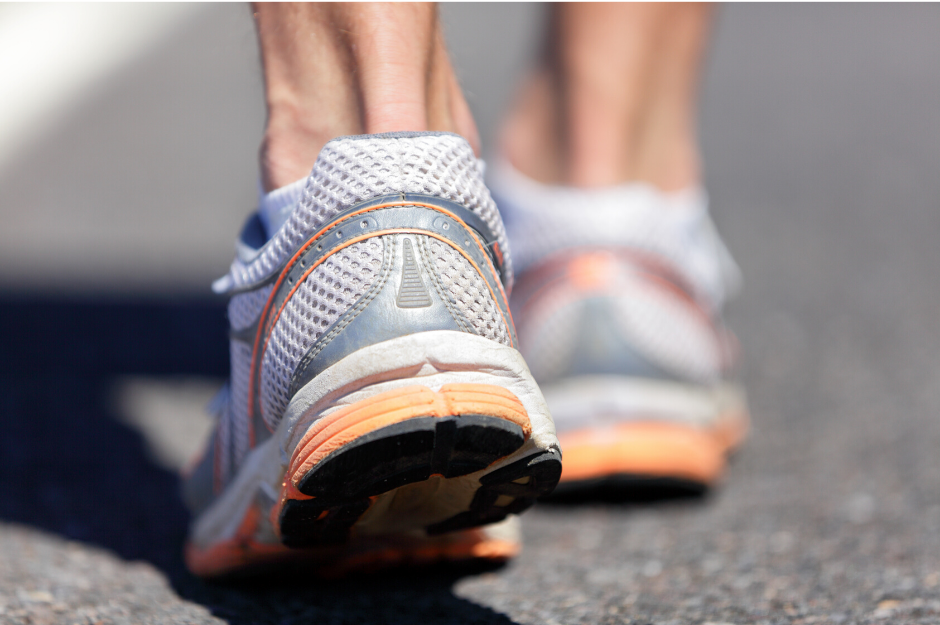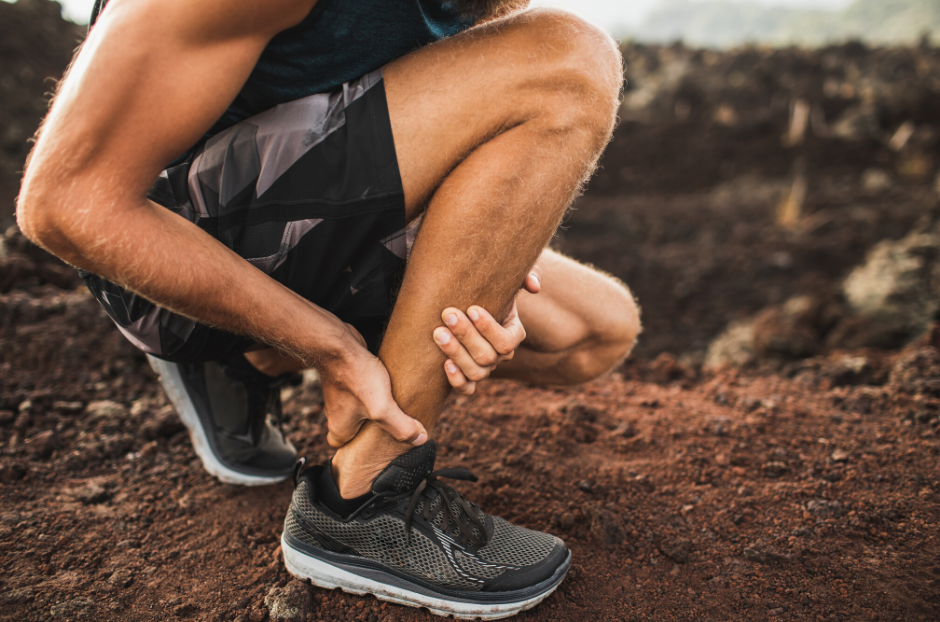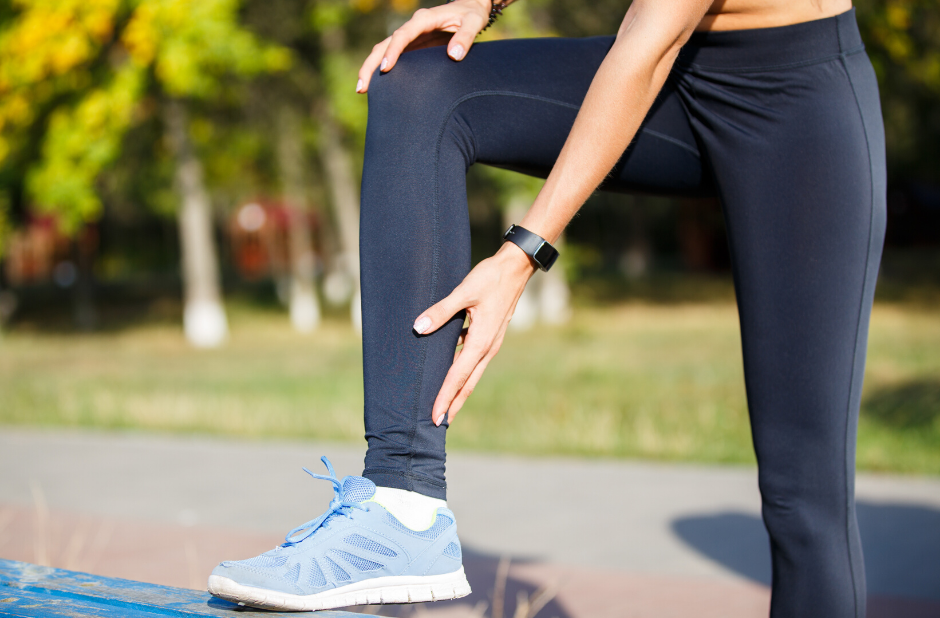 If you’re experiencing pain at the back of your heel that may radiate up back of your lower leg and feels worse when you’re active, it’s likely that you have injured your Achilles tendon – the thickest and most powerful tendon in your body. There are different types of Achilles injuries – and we’ve shared everything you need to know below!
If you’re experiencing pain at the back of your heel that may radiate up back of your lower leg and feels worse when you’re active, it’s likely that you have injured your Achilles tendon – the thickest and most powerful tendon in your body. There are different types of Achilles injuries – and we’ve shared everything you need to know below!
Your Achilles Tendon
Your Achilles tendon is a thick, fibrous band that connects the calf muscles (specifically the gastrocnemius, soleus and plantaris muscles) at the back of your leg to the back of the heel bone (calcaneus).
Every time you walk, run or point your foot downwards, you actively engage your Achilles. While walking can see your Achilles tendon taking on forces of over three times your body weight, running can see it taking on up to ten times your body weight. With this in mind, it’s not surprising that the tendon is vulnerable to being overused and injured – and remains one of the most common sporting injuries that we see and treat.
Injury To The Achilles Tendon
 When the Achilles tendon is injured, you’ll likely feel pain and tenderness at the back of the heel. There may also be some stiffness, swelling, difficulty bearing weight on the injured foot, going up onto your tiptoes and more.
When the Achilles tendon is injured, you’ll likely feel pain and tenderness at the back of the heel. There may also be some stiffness, swelling, difficulty bearing weight on the injured foot, going up onto your tiptoes and more.
We like to be as accurate and informative as possible here at Masterton Foot Clinic, so we’re going to go beyond the ‘norm’ and share with you the technical terms for what kind of Achilles injury you may have. While it may seem overly technical, it’s actually crucial in selecting which treatments will work best for you – and which may not work at all.
Achilles Tendinitis
When your body launches an inflammatory response after your Achilles injury, and you feel noticeable swelling at the back of your heel, this is known as Achilles tendinitis. This usually occurs following an acute injury, with symptoms coming on suddenly. There is likely no underlying and ongoing damage to the tendon fibres, with the micro-tears to the tendon occurring directly as a result of the overloading on that day. Only at this stage, with the presence of swelling, can care like taking anti-inflammatories or using ice can have some beneficial effect in reducing pain.
Achilles Tendinosis
Tendinosis, on the other hand, refers to damage that has been building or continuing for some time (chronically). With the tendon and its collagen degenerating over some time, the tendon fibres change at the cellular level, may scar and become stiff, and the tendon weakens, making it more vulnerable to pain and injury. This is often seen when a tendon is strained and continues to be overused without ever having the chance to heal. The symptoms of this injury usually come on more slowly and gradually, and swelling is notably absent.
Achilles Tendinopathy
Tendinopathy is either used to describe any problem with the Achilles tendon, or often to describe the degeneration of the Achilles tendon over time and no inflammatory response, without specifying the nature of the cause of the injury. It’s not uncommon to see cases of Achilles tendinopathy that have lasted years, with patients noting the pain during running sports like basketball, with the pain coming and going depending on the activity and no inflammation developing.
As the Achilles tendon has a poor blood supply along the length of the tendon and a good blood supply is essential for effective healing and repair, this means that there is a tendency for the tendon to progress into the degenerative state as opposed to staying ‘inflamed’.
What Causes Achilles Pain?
As we mentioned above, it may be from a sudden overuse, or from degeneration over time. Acutely speaking, large amounts of force and strain on the tendon overload it, causing the tendon fibres to become damaged and sustain micro-tears. At its worst, partial tears or even complete ruptures may result.
 Many activities can strain the Achilles tendon as the tendon is used for every step we take. Common causes include:
Many activities can strain the Achilles tendon as the tendon is used for every step we take. Common causes include:
- Increasing training intensity
- Increasing hill running duration
- Unsupportive footwear with low set heels
- Tight calf muscles
- Abnormal foot biomechanics that exacerbates the pull on the calves and Achilles
- Running/jumping sports such as basketball
One of the greatest causes of developing ongoing Achilles problems is ignoring early Achilles pain and continuing to exercise in the hopes that it will resolve. When pain occurs in the Achilles tendon, it’s important that you stop the activity causing the pain.
Treating Achilles Pain
The time for an acute injury (tendinitis) to heal can range from several days to 6 weeks, with tendinopathy or tendinosis potentially exceeding 6 months, depending on the severity of the injury.
Treating the Achilles tendon requires a completely tailored approach and consideration to your unique foot biomechanics. We may use:
- Orthotics – by adjusting the biomechanics of your lower limbs (the way your feet and legs move and function) and adding support where it is needed, we’re able to reduce strain from the Achilles tendon to help prevent repetitive overuse
- Shockwave treatment – shockwave is a safe and effective treatment that is proven to accelerate your healing and recovery from Achilles pain. We’re proud to be the only clinic in the area to have this treatment available at present.
- Foot mobilisation – foot mobilisation uses hands-on manipulation to work on stiff and dysfunctional joints to best support your recovery
- Footwear – ensuring you’re wearing footwear that is supporting your recovery and not hindering it
- Stretching – light stretching as prescribed, to help preserve the motion and flexibility through the Achilles and discouraging it from shortening, as well as positively impacting the chemical changes involved in the degeneration process
- Strengthening – using eccentric strengthening, as prescribed, has been proven to be effective in helping treat tendinosis
- Changes to regular activities – modifying activities to allow the tendon to heal and not continue to be overused
Strapping At Home For Achilles Pain
Here is a simple and effective strapping technique to help reduce the tension on the Achilles tendon, which in turn reduces your pain and improves your comfort as you recover from an Achilles injury.
[embedyt] https://www.youtube.com/watch?v=vNz7uYLrZng[/embedyt]
FAQs
What kind of shoes should I wear if I have Achilles pain?
We always recommend wearing supportive sneaker-style shoes that are right for your foot type. In the case of Achilles pain specifically, having a slight heel can also help relieve some strain away from your Achilles tendon, whereas completely flat shoes like jandals or low-set soccer boots can exacerbate your pain.
How can I tell the difference between Achilles pain and heel pain?
Achilles pain is felt in the strong cord-like tendon at the back of the heel that moves up into the calves. If you pinch the tendon close to where it attaches at the back of the heel, it is likely to elicit pain. Heel pain is felt more at the bottom of the heel and may radiate through the arch or on the inside of the heel too.
Why do you offer a specialised Achilles pain treatment plan?
The Achilles tendon takes on the most force out of any of the tendons in the body, and while it’s incredibly strong, it is also prone to injury, especially in those that are active. We see countless people with Achilles pain each year – both those with relatively new Achilles pain and those that have been struggling with Achilles pain for years. As a result, we’ve refined our processes over time to create specialised and proven treatment plans that we know work. This is where our Active Achilles plan came from.
Is Achilles pain the same as growing pains in kids?
Both growing pains in the heels and Achilles pain involve the Achilles tendon, and produce pain at the back of the heel, but they are different conditions. Achilles pain indicates damage to the Achilles tendon, whereas growing pains at the heels occur because the growth plate that is located at the back of the heel bone is irritated and inflamed. This irritation may be caused by the Achilles tendon – but the Achilles tendon isn’t the one that is damaged in growing pains. You can read more about what growing pains are here.
How long does it take for Achilles pain to get better?
The Achilles tendon has some unique characteristics that can make it more difficult for it to recover from injury – like that it has a poor blood supply, which is essential for healing and repair. As such, we expect your Achilles pain to significantly improve within 6-12 weeks, and for the pain to be completely resolved within 6-12 months.
Can I still go to the gym if I have Achilles pain?
Yes, but the things you do at the gym will depend on the severity of your injury and where you are in your recovery. Your podiatrist will advise you about exercise and activity at your appointment – and we will also be adding some Achilles-specific stretching and strengthening to your gym routine when the time is right.
Is Achilles pain treatment covered by health insurance?
This is dependent entirely on your policy and level of cover. If your policy covers podiatry, then it is likely your insurer will be able to assist. Please contact your insurer directly to confirm.
Is Achilles pain treatment covered by ACC?
If your Achilles pain is a result of an accident, then you may be eligible for ACC. We can fill in a claim form for you and submit it to ACC, who will ultimately decide if your injury is covered.
References
https://www.ncbi.nlm.nih.gov/pmc/articles/PMC3312643/
